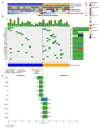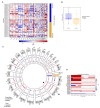Genomic Profile in a Non-Seminoma Testicular Germ-Cell Tumor Cohort Reveals a Potential Biomarker of Sensitivity to Platinum-Based Therapy
- PMID: 35565196
- PMCID: PMC9101377
- DOI: 10.3390/cancers14092065
Genomic Profile in a Non-Seminoma Testicular Germ-Cell Tumor Cohort Reveals a Potential Biomarker of Sensitivity to Platinum-Based Therapy
Abstract
Despite having a favorable response to platinum-based chemotherapies, ~15% of Testicular Germ-Cell Tumor (TGCT) patients are platinum-resistant. Mortality rates among Latin American countries have remained constant over time, which makes the study of this population of particular interest. To gain insight into this phenomenon, we conducted whole-exome sequencing, microarray-based comparative genomic hybridization, and copy number analysis of 32 tumors from a Mexican cohort, of which 18 were platinum-sensitive and 14 were platinum-resistant. We incorporated analyses of mutational burden, driver mutations, and SNV and CNV signatures. DNA breakpoints in genes were also investigated and might represent an interesting research opportunity. We observed that sensitivity to chemotherapy does not seem to be explained by any of the mutations detected. Instead, we uncovered CNVs, particularly amplifications on segment 2q11.1 as a novel variant with chemosensitivity biomarker potential. Our data shed light into understanding platinum resistance in a Latin-origin population.
Keywords: CGH; CNVs and DNA breakpoints; SNVs; TGCT; WES; platinum-resistance.
Conflict of interest statement
The authors declare no conflict of interest.
Figures






Similar articles
-
Genomic landscape of platinum resistant and sensitive testicular cancers.Nat Commun. 2020 May 4;11(1):2189. doi: 10.1038/s41467-020-15768-x. Nat Commun. 2020. PMID: 32366847 Free PMC article.
-
Genomic screening of testicular germ cell tumors from monozygotic twins.Orphanet J Rare Dis. 2014 Nov 26;9:181. doi: 10.1186/s13023-014-0181-x. Orphanet J Rare Dis. 2014. PMID: 25424124 Free PMC article.
-
Integration of genomic copy number variations and chemotherapy-response biomarkers in pediatric sarcoma.BMC Med Genomics. 2019 Jan 31;12(Suppl 1):23. doi: 10.1186/s12920-018-0456-5. BMC Med Genomics. 2019. PMID: 30704460 Free PMC article.
-
New insights into germ cell tumor genomics.Andrology. 2019 Jul;7(4):507-515. doi: 10.1111/andr.12616. Epub 2019 Mar 21. Andrology. 2019. PMID: 30896089 Review.
-
Further insights into testicular germ cell tumor oncogenesis: potential therapeutic targets.Expert Rev Anticancer Ther. 2020 Mar;20(3):189-195. doi: 10.1080/14737140.2020.1736566. Epub 2020 Mar 12. Expert Rev Anticancer Ther. 2020. PMID: 32164473 Review.
Cited by
-
Breaking the Mold: Epigenetics and Genomics Approaches Addressing Novel Treatments and Chemoresponse in TGCT Patients.Int J Mol Sci. 2023 Apr 26;24(9):7873. doi: 10.3390/ijms24097873. Int J Mol Sci. 2023. PMID: 37175579 Free PMC article. Review.
-
Racial/ethnic differences in trends of testicular germ cell tumor incidence in the United States, 1992-2021.Cancer. 2025 Jan 15;131(2):e35706. doi: 10.1002/cncr.35706. Cancer. 2025. PMID: 39760469 Free PMC article.
-
Integrated Molecular Analysis Reveals 2 Distinct Subtypes of Pure Seminoma of the Testis.Cancer Inform. 2022 Oct 31;21:11769351221132634. doi: 10.1177/11769351221132634. eCollection 2022. Cancer Inform. 2022. PMID: 36330202 Free PMC article.
-
Targeting CLDN6 in germ cell tumors by an antibody-drug-conjugate and studying therapy resistance of yolk-sac tumors to identify and screen specific therapeutic options.Mol Med. 2023 Mar 29;29(1):40. doi: 10.1186/s10020-023-00636-3. Mol Med. 2023. PMID: 36991316 Free PMC article.
-
Understanding Sociodemographic Factors among Hispanics Through a Population-Based Study on Testicular Cancer in Mexico.J Racial Ethn Health Disparities. 2025 Feb;12(1):148-160. doi: 10.1007/s40615-023-01859-0. Epub 2023 Nov 14. J Racial Ethn Health Disparities. 2025. PMID: 37962789 Free PMC article.
References
Grants and funding
LinkOut - more resources
Full Text Sources

